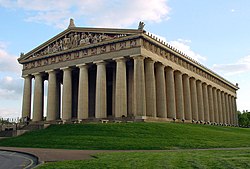Parthenon (Nashville)
The Parthenon (Nashville) | |
 The Parthenon in Nashville's Centennial Park is a full-scale reconstruction of the original Greek Parthenon | |
| Location | Nashville, Tennessee |
|---|---|
| Built | 1897 |
| Architect | William B. Dinsmoor, Russell E. Hart[1] |
| NRHP reference No. | 72001236[1] |
| Added to NRHP | February 23, 1972 |
The Parthenon in Nashville, Tennessee is a full-scale replica of the original Parthenon in Athens. It was built in 1897 as part of the Tennessee Centennial Exposition.
History
Early
Nashville's moniker the Athens of the South influenced the choice of the building as the centerpiece of the 1897 fair. A number of buildings at the Exposition were based on ancient originals. However, the Parthenon was the only one to have been conceived as an exact reproduction. It was also the only one to have been preserved.
Originally built of plaster, wood, and brick, it was rebuilt in the 1920s on the same foundations, but with concrete.
Recent
Today, the Parthenon, which functions as an art museum, stands as the centerpiece of Centennial Park, a large public park just west of downtown Nashville. Alan LeQuire's 1990 re-creation of the Athena Parthenos statue is the focus of the Parthenon just as it was in ancient Greece. The building is a full-scale replica of the Athenian original; and the statue of Athena Parthenos within is a reconstruction of the long lost original to careful scholarly standards: she is cuirassed and helmeted, carries a shield on her left arm and a small statue of Victory in her right palm, and stands 42 feet high, gilt with more than eight pounds of gold leaf; an equally colossal serpent rears its head between her and her shield. Since the building is complete and its decorations were polychromed (painted in colors) as close to the presumed original as possible, it is arguably a better representation of what the Athenians would have seen than is the current ruin of the Parthenon on the Acropolis of Athens.
This replica of the original Parthenon in Athens serves as a monument to what is considered the pinnacle of classical architecture. The plaster replicas of the Parthenon Marbles found in the Naos (the east room of the main hall) are direct casts of the original sculptures which adorned the pediments of the Athenian Parthenon, dating back to 438 BC. The originals of these fragments are housed in the British Museum in London.
As an art museum, the Parthenon's permanent collection is a group of 63 paintings by 19th and 20th century American artists donated by James M. Cowan. Additional gallery spaces provide a venue for a variety of temporary shows and exhibits.
In the summertime, local theatre productions use the building as a backdrop for classic Greek plays such as Euripides' Medea and Sophocles' Antigone, performing (usually for free) on the steps of the Parthenon. Other performances, such as Mary Zimmerman's Metamorphoses, have been done inside, at the foot of Athena's statue.
The Parthenon served as the location for the political rally in the climactic scene of Robert Altman's 1975 film Nashville.
Gallery
-
During reconstruction in the 1920s
-
The east façade of the Parthenon
-
Inside the outer wall of columns
References
- ^ a b "National Register of Historical Places - Tennessee (TN), Davidson County". National Register of Historic Places. National Park Service. 2007-03-03.



